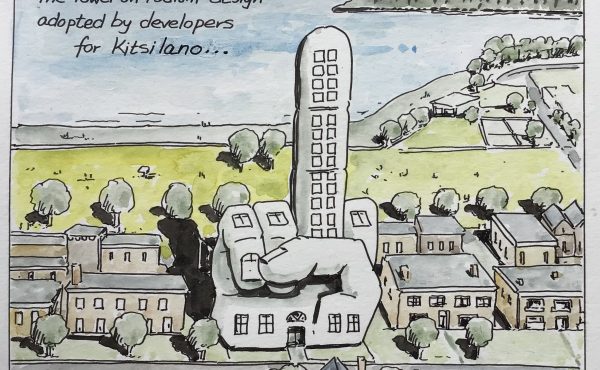
Editors: Dana Cuff and Roger Sherman (Princeton Architectural Press, 2011)
In his well-known 1978 book – Collage City – architectural theoretician and critic Colin Rowe observed that the problem of architecture in his day was its perpetual fluctuation “between a retarded conception of science and a reluctant recognition of poetics.” The twin towers of the World Trade Center had been standing for five years, and the levees of New Orleans had yet to be tested. Still, the problems of the city were as challenging for him then as they are now almost 35 years later.
With the ten year anniversary of 9/11 just months away, Princeton Architectural Press and cityLAB present us here with Fast Forward Urbanism: Rethinking Architecture’s Relationship with the City – a treatise that asks some very tough questions regarding urban landscape and the buildings that create it. In many ways, the book is a call to arms, a current and concise statement of the direction architecture and its allied arts needs to go in quickly, lest they be disenfranchised by the economic and civic forces that are presently shaping our cities.
As editors Dana Cuff and Roger Sherman believe, the city is and always has been a paradox for the architect, “it intrinsically demands design, yet inherently resists it.” To demonstrate, the editors have assembled a formidable group of designers and essayists to sound this clarion call for change – the resulting book comprised of ten essays with accompanying projects, including Will Alsop’s Sharp Centre in Toronto.
Founded at UCLA in 2006, cityLAB is a now well-established think tank which the Department of Architecture and Urban Design formed to seed the ideas for a new school of thought. Through collaborating with similar departments at Rice, Princeton, and the University of Toronto, cityLAB explores the challenges facing the 21st century metropolis through research and design with the motivation of expanding the possibilities for cities to become more livable, sustainable, and beautiful. At the core of this new school is the idea that something fundamentally wrong has occurred between architecture and the contemporary urban landscape.
With the need to reestablish what should’ve been a symbiotic relationship between architecture and the city, cityLAB purports that there are opportunities for effective interaction in new and previously not possible ways of conversing. The city is more than the sum of its parts, and therefore neither the modern and post-modern schools of architecture, nor civic planners and policy makers, could predict many of the relationships between built-form and communities that currently exist. All of the projects presented in Fast Forward Urbanism take advantage of these opportunities and present new models for design in our urban environments, in the hope of opening up a new dialogue between architects and the civic-commercial forces that shape our cities.
The projects and essays presented are divided into three sections – Recycling Ecologies, Rerouting Infrastructure, Regenerating Economies – and while they are the main focus of the book, it is really the book’s introduction which most aptly summarizes cityLAB’s work as picking up where Rowe and Koestler’s aforementioned Collage City left off. Describing what they see as the current models presently being used by architecture-urbanists – the Modern Project, the Dutch Distinction, and Landscape Urbanism – Dana Cuff and Roger Sherman present eight new schools of exploration possible within the city, the understanding of which is vital to effectively understand the contents of the book. Offered up as they are, these new ‘eight points’ are summed up as follows:
1) The Radical Increment – The idea here is that the urban environment is an accumulation of ‘radical increments’, or particular projects not necessarily evolved out of some larger urban strategy. Meant to compliment the developer’s business-as-usual model, it is one that “offers the architect an opportunity to transform the life and imageability of the city through entrepreneurship” – Vancouver’s podium-tower building type would be seem as an example of this.
2) In Vivo rather than In Vitro – At the root here is that new design strategies achieve newness by reconfiguring existing behaviors and protocols rather than concocting new ones. Put simply: cities are taking on lives of their own, and architects are the ones best suited to define their new programs.
3) Identity and Experience – This school celebrates the ‘city as entertainment’ model and that “….urbanism is driven by the realization that urban experience has been commoditized, and so it is now possible for architecture to be both critical and commercial, perhaps becoming more urban in the process.”
4) Recasting the Performative – The idea here is that architecture is more than just a performance and is capable of performing two or more different tasks at once. As an example, the editors present the Trojan Horse, which was able to present itself as a gift while concealing its subterfuge. It is in this way that Cuff and Sherman propose architecture could emancipate itself from its typical role of being ‘icon’ or ‘infill’.
5) Infrastructure as Catalytic – This school puts forth the concept that infrastructure has become more complex with the advances made possible by new technologies (satellite TV, internet, etc.) and as a result may become more of an organizing principle to the spaces of the city than it has traditionally.
6) Plastic Ecologies – This model looks at the implications of the evolving definition of ecology, which no longer is able to differentiate the natural from the artificial. Nature is seen through the lens of culture and this can inform a new relationship between nature and the city – of which architecture would play an integral part.
7) The Question of Contingency – This notion embraces the idea that cities are always changing, and that any urban strategy to be employed must be malleable.
8) Negotiating Discourses – This model reaffirms the architect’s long role as graphic communicator, stressing the importance of visual information in the realization of new urban possibilities.
Over and above the introduction, Stan Allen’s essay ‘Urbanisms in the Plural’ – the first of ten the editors have selected for the book – is a poignant and timely examination of the question first posed by Jane Jacobs: “What does the city want?” As he sees it, of the three current models – the Modern Project, the Dutch Distinction, and Landscape Urbanism –he believes Landscape Urbanism to be the most viable, though he points out that it doesn’t “propose tools to deal with dense urban conditions or to effectively integrate architecture and infrastructure.”
The remaining nine essays are equally as timely, ranging from editor Dana Cuff’s essay on disaster architecture to raising the alarm bell on aging infrastructure. Running in parallel with the eleven built and unbuilt projects included, Fast-Forward Urbanism makes for a well-rounded book and summary of the future trajectories of cityLAB.
Be warned though, Fast-Forward Urbanism is not light reading – this is a dense theoretical treatise and a monograph of architectural and urbanist ambitions to deal with the new problems posed by the twenty-first century city. As such, it would be a great book for architects, urbanists, academics, city planners, developers, and educators interested in delving deep into the subject. As Stan Allen aptly sums up: “What is required is not a simple reassertion of architecture’s physical presence, but a more nuanced theory that would account for both structures and effects, organization and information, weightless bits and dense matter.”
***
For more information on Fast-Forward Urbanism go to Princeton Architectural Press.
For more information on cityLAB go to their website.




